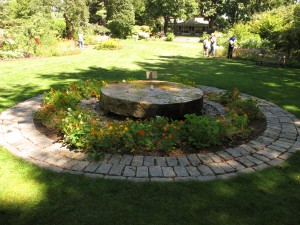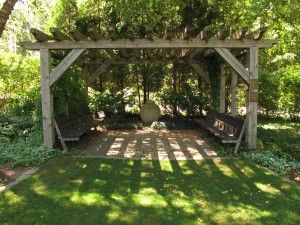Designing a Garden, and Expanding Your Plant Palette
Want to have a spectacular flower garden? Nothing beats visiting a good garden when it comes to learning how to make your own better. I recently visited Kirkwood Garden on Rte 3 in Holderness, NH. I had visited it last spring when I was invited to speak at the Squam Lakes Natural Science Center. I was bowled over by the plant diversity, the beauty of the layout, and the tranquility of the garden. But I didn’t have my camera and notebook, so I went back in August and was once again delighted – and instructed – by the garden.
It is easy to look at a professionally designed and maintained garden and say, “I could never do that.” And for many gardens that’s true. Longwood Gardens in Pennsylvania or the Brooklyn Botanical Gardens encompass dozens of acres and are maintained by teams of workers year round. But Kirkwood Garden is less than an acre (in my estimation) and I’m told it is maintained by a single gardener. And it has not been around for decades. It was installed in 1996 – largely by volunteers, and with many donated plants.
So what pleases me so much about this garden? First is the overall design and layout. If you walk down three broad stone steps, you are on a large central lawn – but one that is carved up and delineated by curved flower beds, islands and walkways that head off to shady nooks. No straight lines here. I like that. And there are places to sit, with nice 2-foot square flagstones laid out in front, so that dozens of daily feet will not create bare spots. And there are shady places as well as sunny places to sit.
Each bed is backed by shrubbery, with the tallest plants towards the back. When I visited in spring, the rhododendrons, azaleas and mountain laurels were in bloom. Many different varieties, each with a different color and slightly different bloom time. Now there is summersweet clethra (Clethra alternifolia) with its intense sweet blossoms, and a lovely viburnum (Viburnum sieboldii) loaded with red berries held upright on bright yellow stems.
Also in the back of the beds – and blooming now – are many tall perennials. I grow and love snakeroot (also called bugbane, but technically Cimicifuga racemosa). But instead of a couple of plants, someone has planted many, or allowed them to spread over the 17-year life of the garden. I tend to have many varieties of plants inter mingled. They have many large stands of a single species, which makes a bold design statement.
A tall fall plant I have only tried once, and not found to be worth keeping, is Boltonia (Boltonia asteroides). They selected a variety called ‘Snowbank’, which my reference text tells me is unlike most boltonias, in that it is self supporting. It is 3-5 feet tall at Kirkwood and stands up without support, while the generic boltonia I tried was 5-6 feet tall and flopped over. At Kirkwood it has formed a cluster about 8 feet wide and 5 feet across and each stem supports a very small white daisy-like blossom. I shall try again.
Speaking of flopping, some annuals (purple cone flower, for one) were supported by horizontal grids of wire. Green wire mesh with 2 inch openings was supported on bamboo stakes about 18 inches off the ground (parallel to the ground) allowing stems to grow through the wire,. The wire was unobtrusive and kept the tall flowers from flopping. Very clever – but will I remember to do that next spring? And will you?
An unusual fall bloomer at Kirkwood, which I have only rarely seen used, is yellow waxbells (Kirengeshoma palmata). This is a shade loving perennial with large maple-looking leaves and large yellow flowers. I have to admit it is slug bait, for me, but on a good year it can be a wonderful addition to a shady garden in the autumn. It is technically only hardy to Zone 5 (minus 20 in winter) but it has survived colder temperatures in my garden.
I learned there that the gorgeous bright red cardinal flower (Lobelia cardinalis) will survive in ordinary garden soil – not just in wet places (which is where it grows in the wild, and where I have it in my garden). Just plant in with some afternoon shade. I shall try that, too.
What else did I like about Kirkwood Gardens? It has maps everywhere, which although initially difficult to figure out, actually work quite well. You can learn the names of lots of different plants, annuals, perennials and woodies. And the garden is open year round and free to all. Donations are gratefully accepted. So you can visit often and see how special plants look in the different seasons.
Last of all, I agree with Barbara Gillan of Stillwater, N.J, who I met while admiring the garden. She and her family visit every year and remarked, “It’s a great place to go when you want to daydream.”
Henry’s web site is www.Gardening-guy.com. His newest book is a fantasy-adventure for children, Wobar and the Quest for the Magic Calumet.




